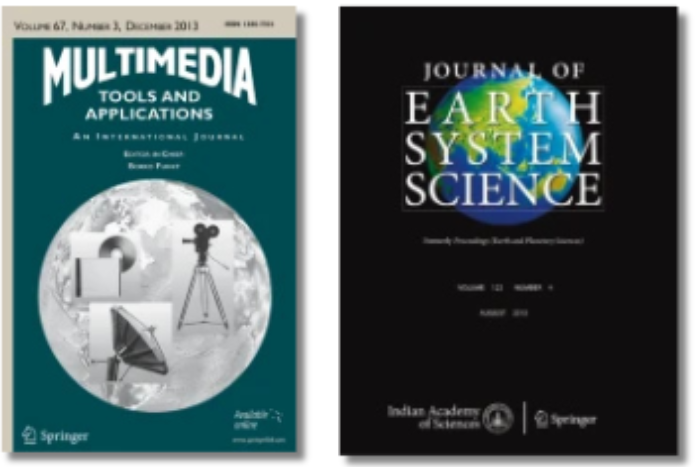Two papers on a novel approach for flood prediction have been retracted for “substantial overlap” between the works. The authors, including Debopam Acharya, dean of the School of Computing at DIT University in Uttarakhand, India, are contesting both retractions.
The articles, published in 2023, are “FLOODALERT: an internet of things based real-time flash flood tracking and prediction system,” which appeared in Multimedia Tools and Applications, and “An IoT-based system for monitoring and forecasting flash floods in real-time,” from Journal of Earth System Science. They have been cited seven and five times, respectively.
The articles were retracted after a concerned researcher, who also reached out to Retraction Watch, emailed each journal about problems with the papers.
Similarities between the publications include the authors’ proposal of a “novel technique” to “estimate river discharge based on sectional area and flow of the river,” the proposed architecture for data collection and prediction, and proposed mobile application for “real-time monitoring.” A comparison of the two documents shows much of the content, including the figures and most of the text in the introduction, results, discussion and conclusion, is shared.
Springer Nature, the publisher of both journals, replied to our request for comment by reiterating the retraction notices, which were nearly identical for the two papers.
“The Editor-in-Chief has retracted this article because it contains substantial overlap in text and figures with two previous publications,” the December 2024 notice in JESS reads. The MTA notice references overlap with “another published article” but not the figures.
Acharya told us in an email the authors are “challenging” the retractions.
Anurag Barthwal, a researcher at Apeejay Stya University in Haryana, India, and the corresponding author on the articles, said the papers were retracted because “they have some overlapping text, images and a table, in the literature review and hardware architecture sections. It happened because of the mistake of research scholar [sic].”
The MTA manuscript was received Oct.13, 2022, three months after authors submitted the JESS manuscript, on July 18, 2022. Both papers were revised and accepted after a different article on the topic was published in IEEE Sensors Journal (IEESJ) by the same authors.
That paper, “FLOODWALL: A Real-Time Flash Flood Monitoring and Forecasting System Using IoT,” was submitted Oct. 8, 2022, and published November 29. It has been cited 14 times.
Both Springer papers bear similarities with this one, including the authors’ “novel approach” for estimating river discharge. Although the IEESJ paper shares fewer similarities with the Springer papers than they do with each other, our analysis concluded it has the same proposed architecture. Tables 2, 3, and 4 as well as figures 2, 4, 5 ,6, and 8 of the paper are the same as at least one of the Springer papers.
“As the submissions deal with different problems related to flash floods, there was no intention to commit misconduct,” Barthwal said. “The [JESS] paper proposed only an architecture, no analysis or prediction. Other papers have different proposed models for analysis and solution approaches.”
In an email seen by Retraction Watch dated March 15, 2024, Marco Jose Da Silva, associate editor-in-chief of IEESJ, told the sleuth who emailed him the “parallel submission to different journals is obviously unethical. However, we at IEEE Sensors Journal were the first to publish the content and could not know about the parallel submissions. Therefore, the authors’ misconduct occurred with their submissions elsewhere, and IEEE is not in a position to address their misconduct.”
However, Carlos Ruiz Zamarreño, the journal’s associate editor-in-chief for publication integrity, had a different take.
From “my point of view there is a clear misconduct of the authors with multiple submissions of the same work to different journals,” Zamarreño wrote in an email to editor-in-chief Zeynep Celik and seen by Retraction Watch. He noted that although the IEESJ article was published first, the manuscript was actually accepted after the authors submitted their manuscript to JESS. He stated IEEE publication principles dictate authors should disclose if the article was under consideration by any other journals. Zamarreño suggested the authors at least be notified of the policy.
Celik, Zamarreño, and Silva forwarded our request for comment to Francine Tardo, an IEEE spokesperson. Tardo told us in an email the journal “previously reviewed this paper and we have nothing more to add at this time.”
Acharya said IEEE has “already written to us agreeing to our comments, that the work is original. We strongly believe that the others [sic] works will also be treated that way.” He also urged us not to write about the case: “If you or anybody write about this issue that is pending a decision between the author and the journal authorities, we will be forced to take appropriate actions against such writeups.”
Like Retraction Watch? You can make a tax-deductible contribution to support our work, follow us on X or Bluesky, like us on Facebook, follow us on LinkedIn, add us to your RSS reader, or subscribe to our daily digest. If you find a retraction that’s not in our database, you can let us know here. For comments or feedback, email us at [email protected].

Authors, just remove the overlap and update the article! Surely the theme of the second journal is slightly different than the journal of the earlier paper!
Some research findings are too intricate to be condensed into a single paper. I believe it’s acceptable to publish multiple articles from such studies, as long as it doesn’t constitute salami slicing.
However, in this instance, given the significant overlap with the authors’ previous publications, the retractions were warranted. However, I think the authors can still resubmit their work in the future, once the duplications are removed and the content is revised to ensure originality.
the real crime is in the FABRication of DATA and misinformation in the science work